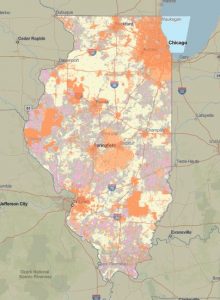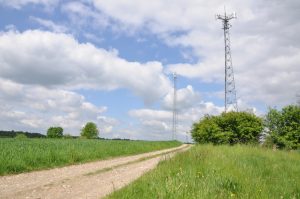New, interactive tool highlights need for improved broadband
By Katie Zelechowski Illinois Farm Bureau — September 7, 2021
An example of tracking broadband availability in different areas across the state. (Courtesy of the Illinois DECO)
A new map created by the U.S. Department of Commerce’s National Telecommunications and Information Administration (NTIA) aims to provide more insight into broadband discussions.
The interactive map is the first of its kind to be made publicly available and compiles data from both public and private sources. Users can search NTIA’s Indicators of Broadband Need tool to identify which communities across the U.S. have reliable internet access and which do not.
This information is especially valuable for rural Americans, who often lack access to strong, affordable broadband services.
Bill Bodine, director of business and regulatory affairs for Illinois Farm Bureau, is hopeful the data collected by NTIA will help inform the organization’s advocacy efforts for improved connectivity.
“Farmers are like everyone else; data and access to the internet can drive business,” Bodine said.
“Hopefully, by compiling some additional data sets into this map, it’ll help people understand where broadband is available and where investments could be made.”
An interactive map outlining the broadband needs of Illinois residents was also released in July.
“Having access to better, more localized data demonstrates that where we really need to be investing in broadband services is in rural Illinois communities,” Bodine said.
Farmers will continue to prioritize internet access as they increasingly rely on precision ag tools to monitor and track things like planting and harvesting conditions.
They also need the ability to transfer data collected in the field to other machines, databases and outside consultants to make informed management decisions.
“Without access to the internet, that data transfer becomes a big problem,” Bodine said.

Illinois Farm Bureau supports funding at the local, state and national levels to help broadband providers invest in serving rural areas.
At the local, state and national levels, Illinois Farm Bureau supports funding to help broadband providers invest in serving rural areas. County Farm Bureaus also engage with local officials to advocate for projects that can improve connectivity for their members.
But projects need to also be completed without infringing on the private property rights of landowners.
“We want broadband in rural areas — we need it for our farmers — but it has to be done in a way that doesn’t create unexpected and unintended consequences,” Bodine said.
Property damage, such as breaking drainage tile while putting fiber optic lines underground, and hazardous situations, like installing lines on existing power poles without enough clearance for farm equipment, are among the potentially devastating consequences.
“As we go forward, the internet and access to broadband are going to be even more critical to our farmers’ operations, so if we can get that service as a quality and affordable service in the future, it’ll pay off benefits for all rural residents,” Bodine said.
To see what broadband coverage looks like in your county, check out NTIA’s online Indicators of Broadband Need tool.



